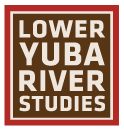Groundwater
Introduction
Groundwater is water that is stored in sedimentary layers underground. The topmost groundwater zone that water drains into is called the unconfined aquifer, and it is usually well-connected to a river. California DWR has long-term groundwater monitoring wells throughout the region spanning 1947-present that can be used to evaluate conditions. DWR and USACE (2003) shows that two sites are right along the river just downstream of the Yuba Goldfields, but none are in the river corridor upstream of that. According to that report, groundwater pumping for agriculture has varied over the decades and is now lower than in the past due to surface water deliveries. Also, excluding surface water diversions for agriculture, more water often appears at Marysville than is present in the river as it passed over Daguerre Point Dam, indicative of extra inflows from groundwater recharge or from Yuba Goldfields surface outflows.
Yuba Goldfields Groundwater Exchange
The Yuba Goldfields are an ~ 10,000 acre, highly disturbed assemblage of landforms in the LYR corridor that resulted from historic industrial gold mining. The industrial operations involved reprocessing gold out of hydraulic mining debris that deposited on the valley floor. The landforms consist of towering lines of coarse sediment with intervening deep lines of ponds. The LYR and the Yuba Goldfields are hydrologically connected by groundwater and hyporheic (i.e. under the river) fluxes as well as by direct surface water connection during floods. River water has been observed to flow into the Yuba Goldfields during high flows and flow out during low flows. YCWA (2009) estimated that there is 500 TAF of storage of flood waters in the Yuba Goldfields.
Past Groundwater Studies
- USACE (2002) performed MODFLOW groundwater simulations that predict hydraulic head throughout the Marysville region.
- YCWA (2007) included groundwater impact analysis, primarily related to diversion flow and agricultural recharge in the vicinity of the LYR.
- Three Rivers (2009) performed an assessment of groundwater in the area south of the LYR in support of levee strengthening work.
- Faunt (2009) reported on groundwater status and usage for the entire Central Valley, including information about the region containing the Yuba River.
No hyporheic flow studies have been performed on the LYR, but there is ample visual evidence of water flowing through the substrate in large quantities. For example, at the upstream end of all surficially disconnected backwaters there is a visible inflow of water straight out of the gravel. The inflow is strong enough to create observable velocities.
Bibliography
- DWR and USACE, 2003. Daguerre Point Dam Fish Passage Improvement Project 2002 Water Resources Studies (Stakeholder Review Draft). Prepared by Entrix, Inc.
- Faunt, C.C. (ed.). 2009. Groundwater Availability of the Central Valley Aquifer, California: U.S. Geological Survey Professional Paper 1766, 225 p.
- Three Rivers Levee Improvement Authority. 2009. Evaluation of Groundwater Impacts from the Upper Yuba River South Levee Repair Activities. Prepared by MWH for TRLIA, November 2009.
- U.S. Army Corps of Engineers. 2002. Analysis of the Yuba River Surface and Groundwater Flows in the Vicinity of Marysville, California. Prepared by Tetra Tech. Sacramento, CA.
- Yuba County Water Agency. 2007. Draft Environmental Impact Report/Environmental Impact Statement for the Proposed Lower Yuba River Accord. Prepared for the Department of Water Resources, Bureau of Reclamation and Yuba County Water Agency by HDR|SWRI. June 2007.
- Yuba County Water Agency. 2009. Preliminary Information Package, Public Information, Hydrology Report. Yuba River Development Project, FERC Project No. 2246
